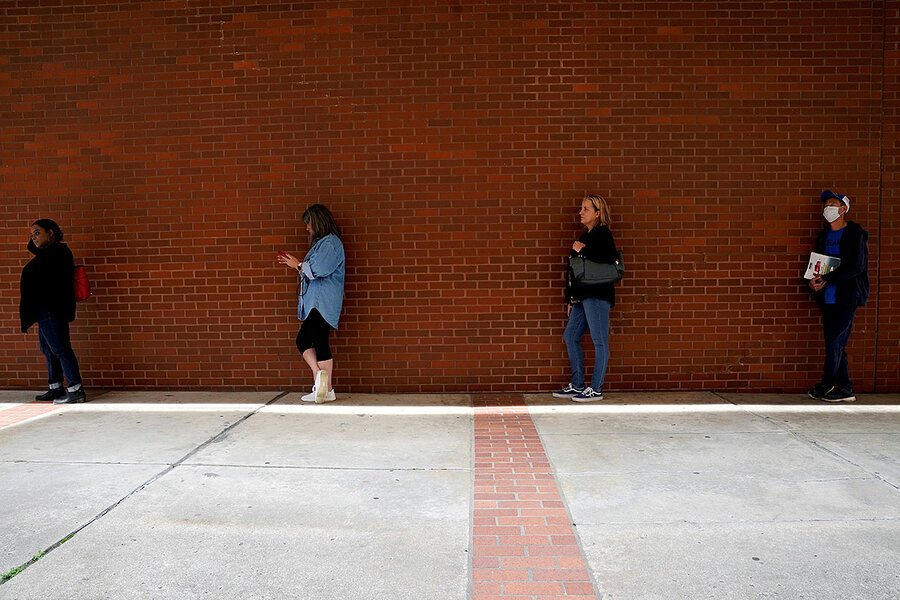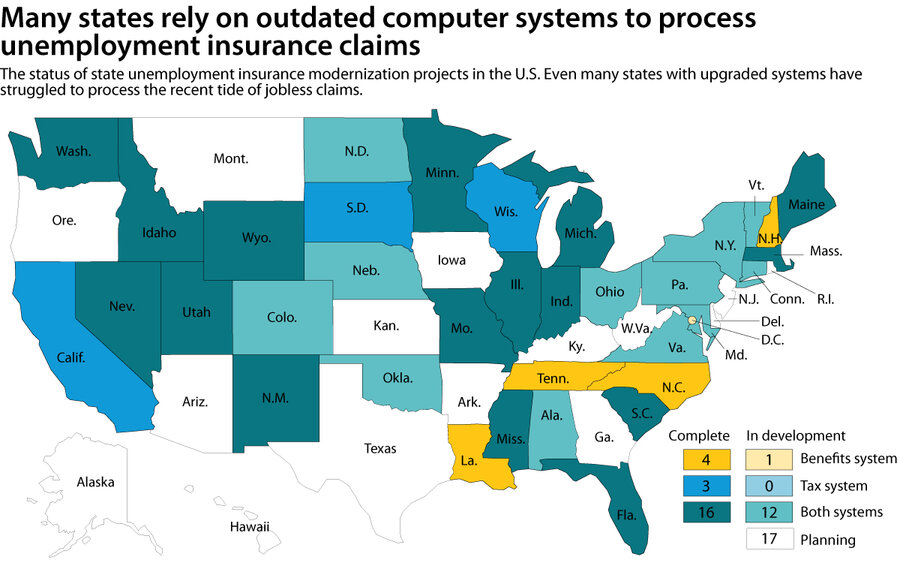Jobless benefits are a lifeline – if the unemployed can get access
Loading...
| Washington
When the Pittsburgh restaurants where Ciara Bailey worked had to close in March, she quickly filed a claim for unemployment benefits. But now, weeks later, she’s still not sure if her claim will be accepted, let alone when her first check will arrive.
“It’s really scary, especially now that money is dwindling,” Ms. Bailey says, describing how she’s stretching to make a food budget last for herself and her 8-year-old daughter.
Why We Wrote This
In economic hard times, unemployment assistance brings rapid, and needed, relief. This time, states are scrambling, and learning lessons in readiness amid a historically fast spike in unemployment.
Similar challenges are playing out for legions of newly unemployed Americans, after efforts to contain the coronavirus brought major parts of the economy to a halt. Millions of jobless claims are being paid. But state agencies that administer the benefits are scrambling to staff jammed phone banks and patch outmoded software. The race to help the unemployed is teaching hard lessons in readiness for a program widely viewed as an automatic stabilizer that people can count on to gear up during economic hard times.
“There has been a lack of attention nationwide to this program,” says Julia Simon-Mishel, a specialist on unemployment compensation at Philadelphia Legal Assistance.
Every morning, Ciara Bailey wakes up at 7:45 a.m., calls the Pennsylvania Department of Labor & Industry when it opens at 8:00 a.m., and waits on hold – only to get disconnected.
Ms. Bailey filed for unemployment in March after both of the Pittsburgh restaurants where she worked closed due to the COVID-19 outbreak. She says many of her co-workers have started to receive unemployment benefits, but a check has yet to arrive in her mailbox.
“It’s scary, it’s really scary, especially now that money is dwindling. Having my daughter, do I go [work] somewhere that’s essential, like a grocery store and work and come home?” says Ms. Bailey, whose 8-year-old daughter has only one lung and has gone to a hospital for flu-like symptoms in the past. “I would be coming home … and putting everybody else at risk too.”
Why We Wrote This
In economic hard times, unemployment assistance brings rapid, and needed, relief. This time, states are scrambling, and learning lessons in readiness amid a historically fast spike in unemployment.
Like so many Americans, the single mother now needs unemployment benefits to survive an economic downturn that is pushing unemployment to rates not seen since the Great Depression. With more than 26.5 million Americans having filed jobless claims in the last five weeks, the very urgency of the problem has made it hard for Americans to tap into vital and promised assistance.
Editor’s note: As a public service, all our coronavirus coverage is free. No paywall.
Millions of unemployment claims are being processed successfully, yet experiences with jammed phone lines, website glitches, and weekslong delays have been nearly as common. The problems partly reflect flawed or outdated software, and partly they reveal a failure of imagination: that a major economic shock could hit so many workers so quickly. The race to help the unemployed is teaching hard lessons in readiness for a benefit widely viewed as an “automatic stabilizer” in economic hard times.
“Right now, for a majority of [jobless] people, unemployment compensation benefits are the only form of income they’re going to have access to,” says Julia Simon-Mishel, the supervising attorney for the unemployment compensation unit at Philadelphia Legal Assistance. “There has been a lack of attention nationwide to this program, so of course states are struggling to process this incredible number of claims.”
Atop it all, efforts by Congress to prevent a wider economic collapse have added extra pressure on states, which administer the nation’s unemployment insurance system. Recent legislation pledges an extra $600 per week in unemployment benefits and widened eligibility so that self-employed or gig workers can qualify. Many states are still struggling to deliver these new benefits.
“For years, state unemployment systems have been underfunded from an administrative perspective,” says Ms. Simon-Mishel.
Some good news: The additional $600 per week is starting to flow in most states, says Andrew Stettner, an unemployment expert at The Century Foundation. The processing of claims seems to be improving, he adds, with 71% of claims submitted since the start of the crisis now registering as insured unemployment.
Ms. Bailey believes her application is on hold because the office denied an earlier unemployment claim she filed after quitting a previous job in February. Repeated attempts to communicate the situation with the office have proved fruitless, and the two emails she received from the office were contradictory and confusing on whether her claim was accepted.
“It was like they read my message and wrote whatever they wanted to. They didn’t answer my questions or anything,” she says.
Stretching a food budget
Currently, Ms. Bailey and her daughter are living off $355 worth of federal nutrition assistance she received on April 13. She’s responsible for a $70 phone bill – her lifeline to the unemployment office – but thanks to a generous landlord, she hasn’t paid rent since February.
To pass the time in quarantine, Ms. Bailey and her daughter, Brooklyn, walk up and down Pittsburgh’s rolling hills, baby dolls in tow. She says she has enjoyed spending more time with her, but that it’s also heartbreaking when Brooklyn asks her for food she can’t afford or why she can’t go outside and play with her friends.
“She’s just sick of eating the same things already and can’t understand that we can’t eat all day right now,” says Ms. Bailey. “I’ve got less than a hundred dollars to my name yesterday, and she’s used to things that she wants me to buy her, and I don’t have the money to. It breaks my heart, you know. What do I do when I can’t give her what she needs?”
Ms. Bailey’s experience notwithstanding, Pennsylvania’s unemployment system appears to have worked about as well as most in this crisis. Pennsylvania began to overhaul its system in 2017 and was on track to roll out the new product this fall, but the economic fallout from the coronavirus has upended this plan.
Analysts say America’s spike in joblessness is undercounted, so far, because so many self-employed or gig workers haven’t been able to file claims. The federal government’s $2.2 trillion economic relief package created pandemic unemployment assistance to expand benefits and cover these people, but states are still in the early stages of enabling their applications.
While no state system has gone unstrained, some are dealing with the new demands better than others. Washington state, for example, has been quicker than many to widen the pool of claimants and roll out enlarged payments.
Along with hiring hundreds of new workers in recent weeks (like some other states), Washington overhauled its system after the 2008 financial collapse and recession – a decision that Employment System Policy Director Dan Zeitlin says helped them avoid a claims-processing disaster.
By contrast, jobless workers in Florida have faced grueling delays. As of last week, the state’s unemployment system has processed only 4% of 850,000 applications since the crisis began in March, according to the Orlando Sentinel.
Why state systems falter
Systems are crumbling due to their rigidity and age. Many of them are decades old and were written in COBOL, a programming language designed in 1959 that fell out of college curriculums in the 1980s. States like New Jersey are scrambling to find coders. And even newer systems aren’t necessarily flexible enough to handle a historically rapid surge in demand.
“Most states are experiencing the equivalent of a [cyber] attack on their website,” says Mr. Stettner, of The Century Foundation. “And even the best ones … are not modernized, they’re not in the cloud. That limits [their] ability for expandability and remote work.”
A report released Thursday by the U.S. Labor Department Inspector General’s office expounded on this theme, citing longstanding concerns including that ”states have been slow to modernize unemployment systems.”
Challenges have been amplified in some states by policy shifts in recent years that reduced benefits or made them harder to access, according to the National Employment Law Project in New York.
Ms. Simon-Mishel in Philadelphia adds that systems are often optimized for state officials, rather than workers.
“I wanted to share a list of best practices to share with the legislature, but I could only find examples of where these projects had gone wrong and what had gone wrong,” she says. “If you’re going to spend millions of dollars upgrading your technology, it should make it easier for workers.”
On Easter Sunday, Ms. Bailey got a two-line email response from the unemployment insurance office indicating she was financially eligible for unemployment benefits. She was thrilled. In a text to the Monitor, she said, “So, that’s a bit of light at the end of the tunnel, hopefully.”
Many days later, though, she still hasn’t been able to submit a claim, much less received money. She worries about her ability to stretch her food and money till next month’s nutrition assistance arrives.
So Ms. Bailey’s morning routine remains the same: wake up, call the office, wait.
Editor’s note: As a public service, all our coronavirus coverage is free. No paywall.










